Archive for the 'Fruit' Category
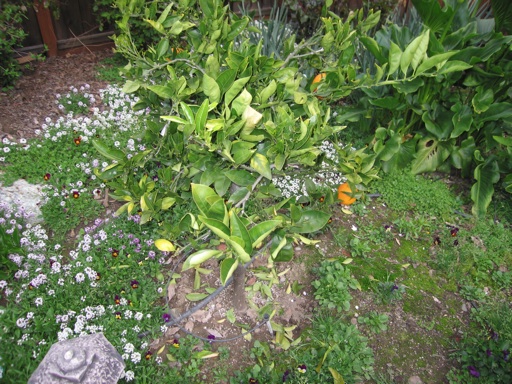
A few weeks ago, I gave our citrus bushes their first application of fertilizer for the season. I have read repeatedly how important it is to fertilize citrus with nitrogen especially in late winter to stimule them to grow and bloom in the spring. I have been using a 16-16-16 all-purpose chemical fertilizer on our citrus. We have two mature orange bushes (below picture), a very small page mandarin bush, and a small navel orange bush (picture above). A week after I applied the fertilizer, the mandarin and the small navel orange bush dropped many of their still green leaves. The picture above show the small navel orange after the leaf drop occurred.
I gave the small orange and mandarin about a cup of fertilizer each, which was probably too much. We had only a few light rain showers in the weeks after I fertilized, and I did not give them supplemental watering. Also, the weather has been cool with many cloudy days in the past few weeks, but we have not had any freezing weather. So I can rule out overwatering and weather conditions as possible causes. Last spring, our small orange lost even more of its leaves within a few weeks after I applied the same fertilizer.
Although leaf drop on citrus can occur for a variety of reasons, I am convinced at this point that the leaf drop has been occurring, because I have been applying too much fertilizer, which burned the roots. I have decided to start using an organic fertilizer on our citrus bushes and to use much less fertilizer, perhaps a third of a cup per application on our small bushes. I have read that organic fertilizer is less likely to burn the roots than chemical fertilizers, because the nutrients in them are much less concentrated. Our mandarin seemed to suffer the most after I gave it fertilizer. That’s strange because it had many yellowing leaves that were a clear sign of nitrogen deficiency. However, it is a very small bush (only about 18″ high), so it was probably more susceptible to root burn.
Our large mature orange bushes did not mind the chemical fertilizer. I gave them about 3-4 cups of fertilizer each. They lost very few leaves after I applied the fertilizer, which seems to confirm what I have been reading that mature trees can handle large doses of fertilizer much better than young trees. In the past few years after giving our 2 large orange bushes a few cups of all-purpose fertilizer in February, they responded by producing an abundance of blossoms and new dark green leaves the following spring.
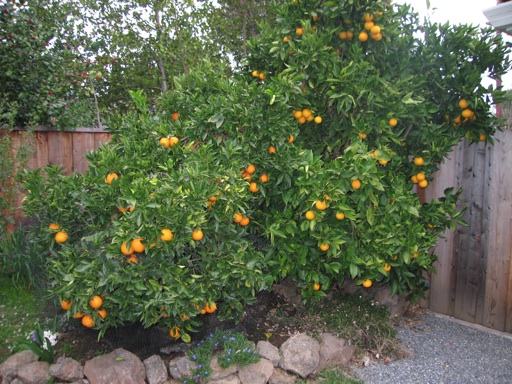
March 07 2010 | Oranges | Comments Off on Leaf Drop on Citrus
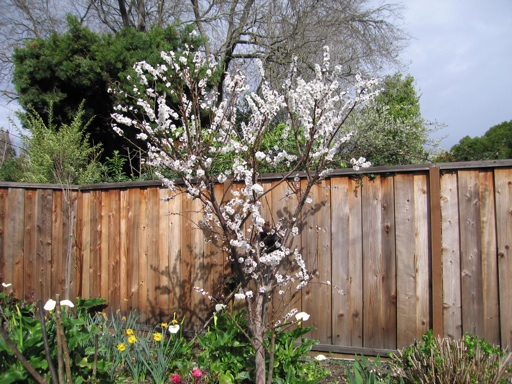
Our 8 year old Blenheim apricot tree just finished its bloom. I took this picture of it last weekend. It started blooming about 2 weeks ago. It was a beautiful but brief bloom. The rain we had here on Tuesday and Wednesday of this week knocked off most of the remaining petals. Our peach, nectarine, and Japanese plum trees are also in bloom now, and there appears to be no shortage of bees pollinating the blossoms.
These trees have always bloomed very early here. Although it varies from year to year, they typically bloom in late February and early March. I think that their tendency to bloom early is part of the reason many peach, nectarine, apricot, and Japanese plums are not recommended for cold climates that are prone to hard freezes late in the season in March and April. An early warm spell could trick them to into bloom and then a subsequent freeze might damage many of the flowers or newly forming fruit.
March 05 2010 | Apricots and Fruit | Comments Off on Apricot in Bloom
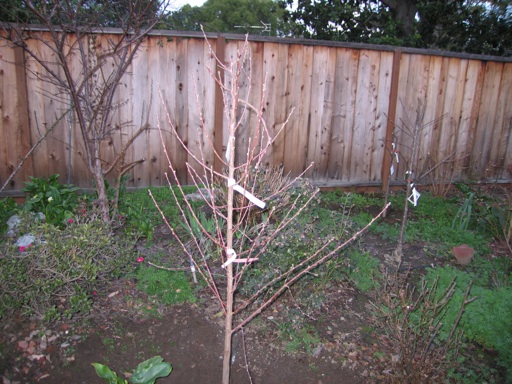

I added a new Arctic Rose nectarine tree to my collection of backyard fruit trees a few weeks ago. The first picture above shows what the tree looked like after I brought it home from the nursery, and the second picture shows how it looked after I pruned it severely, cutting off most of the branches. I have read several resources over the past year about pruning fruit trees. Most of these sources advise home growers to prune fruit trees regularly, especially in the first few years after they are planted when they are still small.
I have always wondered why the branches of many backyard fruit trees bend and break under the weight of the fruit that they bear. Why is it that these trees have not evolved strong enough branches to bear the weight of their fruit? Put another way, why it is that these fruit trees have evolved to bear more fruit than their branches can support the weight of?
The answer is that most of the fruit trees that people grow for food today are not entirely the result of natural selection. Breeders have bred fruit trees such as apples, pears, and peaches to bear large fruits. The wild versions of the fruit trees that we know and love are much more able to support the weight of their fruit, partly because the fruit they bear is much smaller than the cultivated varieties we cherish. For example, today’s large cultivated apples are probably descended from crabapple trees, which produce fruits that are only about 1-2 inches in diameter. Wild peaches trees that grow in their native China produce fruits that are much smaller and more sour that the peaches that are cultivated throughout the world today.
Although fruit tree breeders have been very successful at improving the size and flavor of many modern cultivars of fruit trees, they have not improved the strength of the branches of fruit trees. The only way to do that is to prune often and heavily. Pruning the branches of a tree stimulates the tree to thicken and strengthen the shortened branches that remain, making them much better able to support the weight of a heavy load of large fruits.
I am now pruning my fruit trees 1-3 times a year so that they can support the weight of their fruit without needing supports or causing branch breakage. Depending on how fast an individual tree is growing, I sometimes prune the same tree as often as 3 times per year, in the winter, in the spring, and in the summertime. Many of my fruit trees grow rapidly in the spring after a winter prune. Spring and summer pruning does a good job of reducing the vigorous growth rate of trees. Frequent pruning has kept our fruit trees small so that it is easier to spray them (if needed), net them, harvest the fruit, and perform subsequent pruning.
I have read repeatedly that is especially important to prune peach and nectarine trees heavily, because they grow vigorously and produce many more fruits than they can support. I think that at least 2/3 of the branches of a peach/nectarine tree should be removed each year to control its size and fruit production. If pruning doesn’t do enough to reduce the number of peach or nectarine fruits a tree produces, I will thin the fruits to about 4-6 inches apart in May-June. Thinning the fruit greatly reduces the likelihood of branches breaking. Also, in the years that I thinned my peaches, my O’Henry peach tree has produced peaches that are much larger in size than in the years I have not thinned them.
February 20 2010 | Fruit and Peaches/Nectarines | Comments Off on Severe Pruning of Fruit Trees
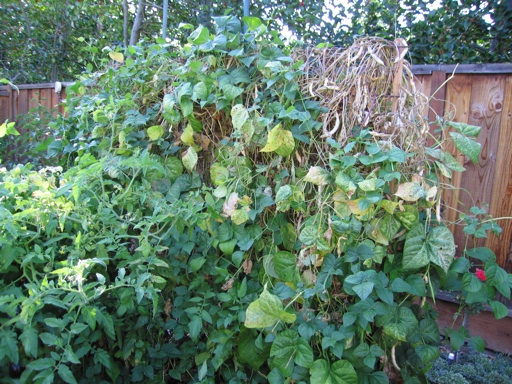
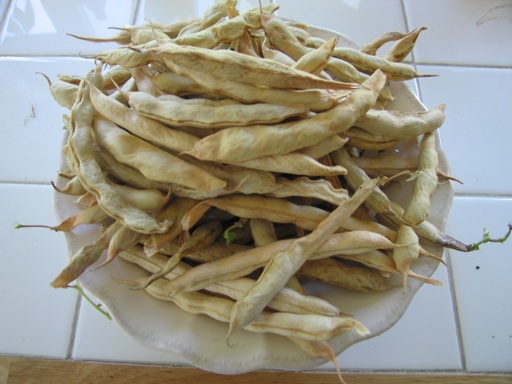
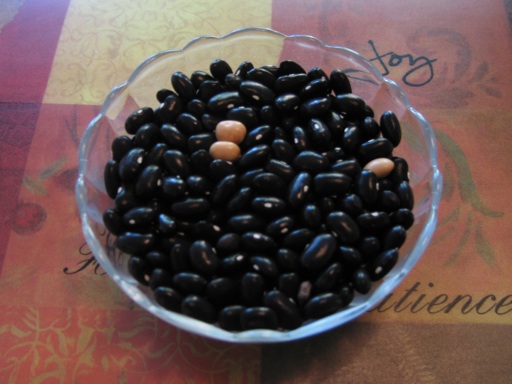
We have been harvesting beans from our pole bean plants since late June. During the summer, they were producing more beans than we wanted to eat, so I didn’t harvest them all. They are starting to wind down their production of beans now, but there are many bean pods left on the vines that have dried up.
Today, I spent about an hour harvesting the dried bean pods and removing the seeds from them. Each fall, I save bean seeds from the dried up beans pods to plant as next year’s crop of pole beans. I place the bean seeds in a zip-locked bag marked with the date I harvested them. Then, I put the bag in a drawer in our kitchen for storage until next spring.
Beans are the only seeds I harvest from our vegetable garden to re-plant for next year. Bean seeds are very easy to harvest, because they are large seeds, and they dry within the pods while they are still on the vine. Other types of vegetable seeds are much smaller and are more of a challenge to pick and dry.
I always make sure to harvest the seeds from bean pods that are completely dried up. The dried up pods crumble in my hands when I break them open. I have noticed that if the bean seeds inside are not completely dry and hard, mildew may start to grow on them while they are in storage.
This year I planted mainly Romano (Italian) beans and some Blue Lake pole beans. The black beans shown in the third picture above are the Romano beans. These types of beans are usually grown for harvest as green beans. But I think the dried black bean seeds from the Romano bean plants can also be cooked and eaten. We have too many dried bean seeds to plant next year in our relatively small vegetable garden, so I am going to try cooking some of them and using them in Mexican dishes.
October 04 2009 | Beans | Comments Off on Harvesting Dried Bean Seeds
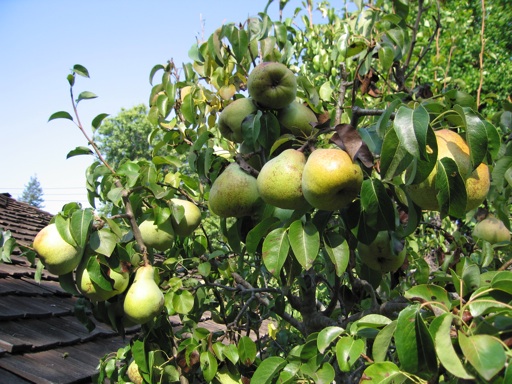
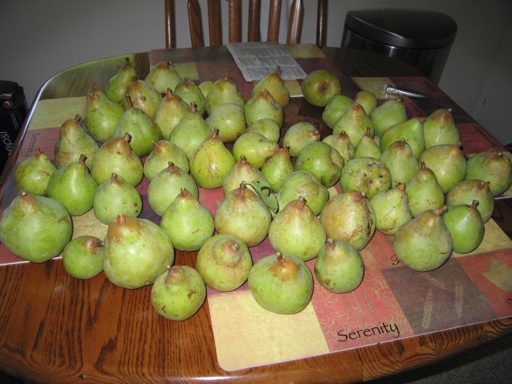
Yesterday, my mom and I harvested about 70 Comice pears from a small tree in my backyard. Our tree is crammed into a small space in between our house and a fence that is only about 6 or 7 feet away from the house and runs parallel to the house. The tree has grown upright in between the house and the fence. This tree was planted by the previous owners of the house. They didn’t pick the best spot, because the tree doesn’t have enough room to grow any wider. However, our Comice pear tree has managed to produce an abundance of pears nearly every year (except the years I didn’t net the tree). This is an example of how a fruit tree can be grown in a small space in a backyard and still produce high quality fruit.
In my opinion, Comice pears are the best tasting variety of pear. In fact, they are one of the best tasting fruits. The comice pears we have harvested from our tree taste even better than Bartlett pears. Our comice pears are very sweet. They are sweeter than Bartlett. Bartlett pears tend to have a bit of tartness, although I am a big fan of those pears as well. We also have a Bartlett pear tree.
Like all pears, Comice pears need to be picked while they are still unripe, and then ripened indoors. The worst thing about Comice pears is having to wait so long to eat them. Comice, Bosc, and D’Anjou pears need to be kept in a refrigerator for at least a month after harvest. After a month in cold storage, they can be brought to room temperature to ripen properly.
September 28 2009 | Pears | Comments Off on Comice Pear Harvest
« Prev - Next »









